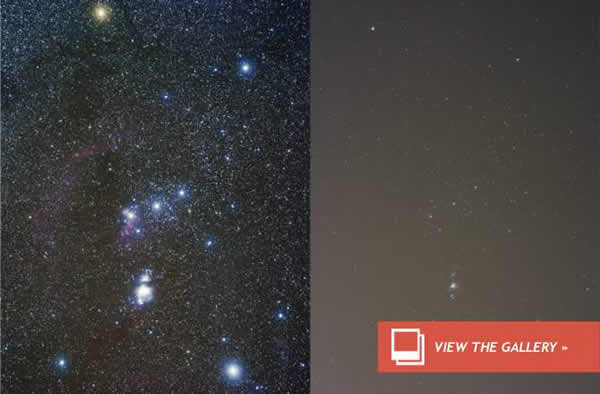Turn Yourself into a Skyglow Meter
There’s a new free app by German researchers that turns your eyes into a skyglow meter. It should make it possible to generate highly detailed light pollution maps anywhere there are amateur astronomers or other sky gazers willing to become citizen scientists and gather data. Since I can be lumped in with those kind of folks, I downloaded the app, called “Loss of the Night,” to my phone yesterday and gave it a try last night.
The first thing I noticed is that app is based on the nifty Google Sky Map app. It requires that you activate the GPS on your phone, input some weather info, then it directs you to seven stars in the sky of varying brightness to roughly determine how bright the light pollution is in your location. So far so good.
The app directed me to stars that were high in the sky, pretty darn close to zenith, which makes sense. But had I known this in advance I would have done this on my back, on a lawn chair. As it was, following the arrow to seven stars high up was pretty uncomfortable and gave me a neck cramp (if you are prone to neck pain, you do not want to do this standing up).
It was also a little tricky sorting out exactly to which stars I was being directed. It helped that I was familiar with some of the stars already, but I can see how some folks not familiar with the constellations might find this a little daunting — or misidentify a star and therefore provide bad data. Since this app is reportedly going to be adding data to the GLOBE at Night citizen science project, I think data quality issues are pretty important.
A example of a dark sky (left) versus a light-polluted sky (right), centered on the well known constellation Orion. Credit: Jeremy Stanley
Another potential source of bad data that could be easily remedied is the lack of any reminder to users about night vision. If I walk out of a brightly lit room into the night and start using the app, the data will be skewed by my still-constricted pupils. The developers have apparently assumed that people will know to allow some time for their night vision to adjust. But you know what they say about assuming. It might be a good idea to include a message at start up, or even a timer, that standardizes the amount of time users wait for their pupils to dilate before starting to look for stars.
Besides these issues, the app is great. Although it’s much harder to use than my old handheld skyglow meter, how many people have those? In fact, I couldn’t even find mine to use side-by-side and compare, and I never remember to take it with me when I go out observing. But I rarely forget my phone and so I expect I’ll be getting a lot more neck cramps this summer.(May 1, 2013 02:24 PM ET // by Larry O'Hanlon)












